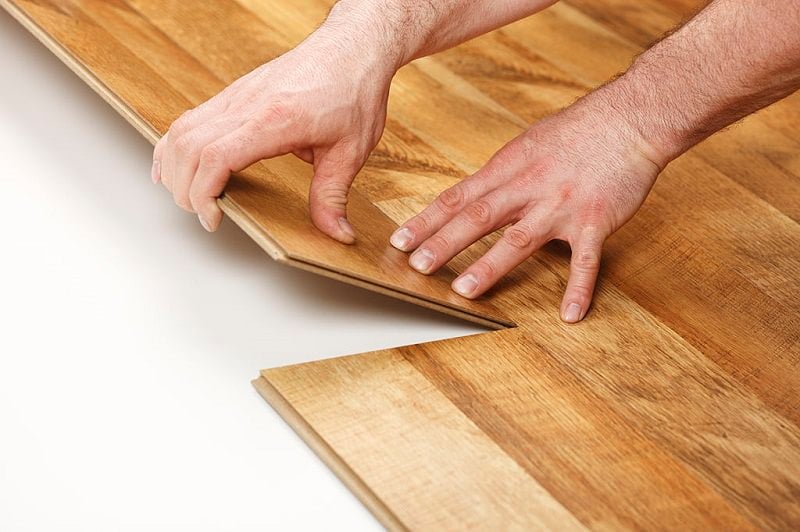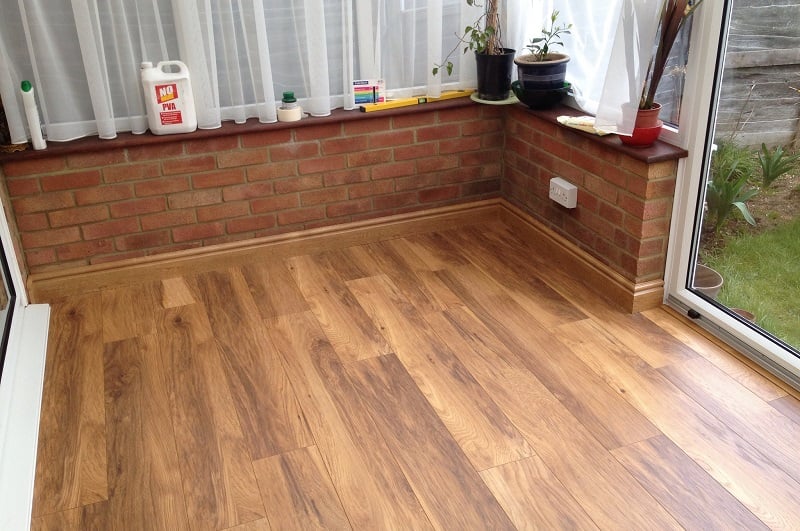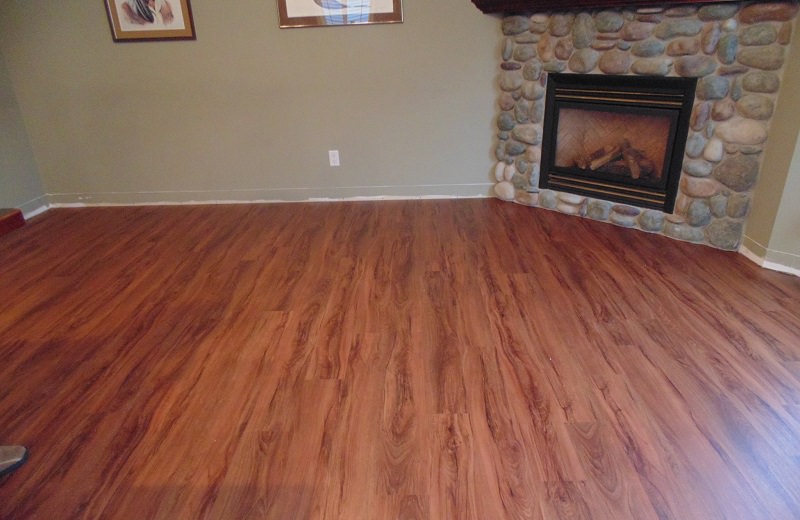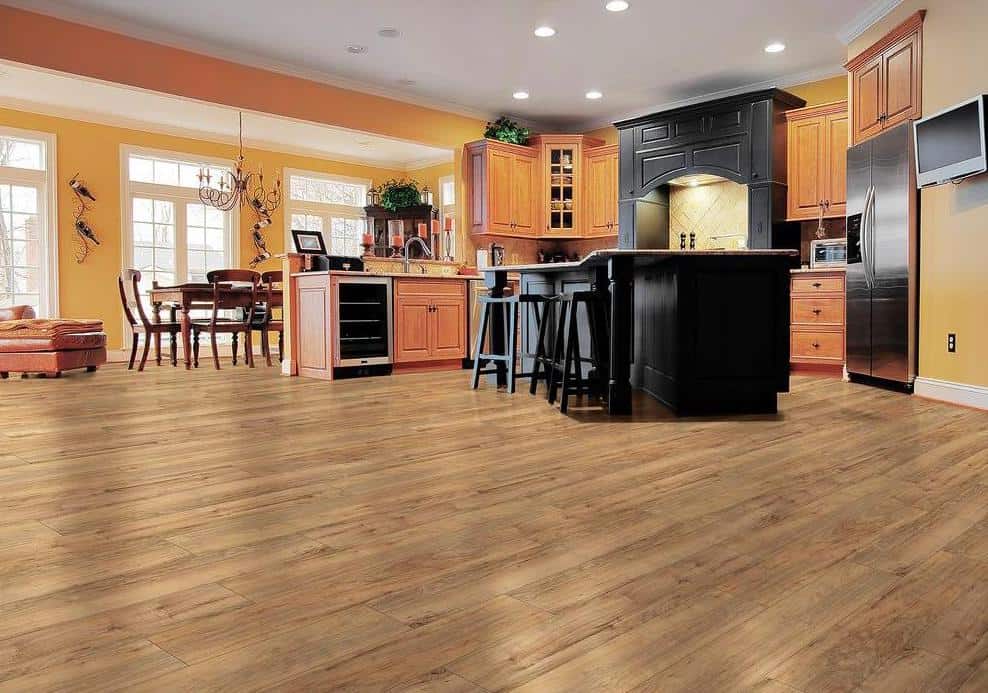
Laminate flooring is one of the most beautiful flooring types that can be installed at an affordable price. Considered by many to be the next big design trend, it imitates wood, tile or stone flooring. Essentially, this flooring is layers of adhered fibreboard with an image of the wood, tile or stone printed on top.
Laminate flooring can give you a realistic looking of wood, tile or stone appearance without the hustle of cleaning soiled grout joints. It is resistant to burns, scratches, and heat, and very easy to maintain.
This type of floor is often confused with real engineered hardwood flooring. Engineered wood flooring is constructed totally from real wood plies that are laminated together. On the other hand, laminate flooring consists of fiber core boards with a photographic print layer and a clear top coating of melamine resins.
Laminate flooring can be used anywhere. Because it isn’t affected by humidity and moisture in the same way as true hardwood, making it a popular choice for below, at, or above grade.
Available in a large selection of styles, colors, and textures, laminate flooring is available in the following types.
Related: Laminate Flooring Cost Calculator | Laminate vs. Vinyl Flooring Comparison | What is Laminate Flooring | Kitchen Floor Tiles | Types of Soundproof Flooring
A. Based on Installation Types
One way you can classify laminate flooring is by installation type. This is especially important to consider if you’re installing the laminate flooring yourself. The different installation types for laminate flooring are:
1. Glue-Less Laminate Flooring

This type of laminate flooring installation uses tiles or planks that do not have glue. You have to get the right method of affixing them to the floor. They are easy to install and are indeed more popular in the market.

2. Glued Laminate Flooring

You’ll need to glue the joints together. While this installation type makes for a very strong floor once installed, its cost and time will be higher than with a glueless type.

3. Pre–Glued Laminate Flooring

Source: LL Flooring
Rather than applying the glue separately, these planks have the glue already applied, so you can just snap the planks into place. Because some edges have to be dampened to activate the glue, you need to check the installation instructions carefully.
You also can not mess with this type of flooring since glue is already applied to the tongue and grooves. It’s also quick and easy to install.
4. Underlayment Attached

These glueless planks come with an included underlayment, so all you need to do is snap them into place. Several types of tongue and grooved locking systems are available. The attached underlayment reduces noise levels.
B. Based on the Material It Imitates
1. Looks Like Wood Flooring
This flooring consists thin layers of solid wood with an upper layer of wood veneer and an acrylic finish that makes it tough and durable. It’s thicker planks than the other laminate options. The models are available in various wooden designs.
Manufacturers with their new tech now offer not only hardwood veneer but also the printed types. You will not notice its difference with solid hardwood. After years of use, laminate wood flooring can be refinished to bring them back to their former glory by lightly sanding them and refinishing the surface.
In fact, you can get laminate flooring to look like all types of hardwood. Here are examples of 19 wood species (via Homedepot).
2. Looks Like Plastic
These are not as popular as wooden laminate, though this material can be versatile. Plastic laminate flooring is made from fiberboard that contains an imposed photo image design.
Thus, there are many different plastic laminate designs to select. You should not use plastic flooring for the bathrooms since this material retains a large amount of moisture.

3. Stone Laminate Flooring

Source: Armstrong Flooring
Laminate with a stone appearance describes the beauty and realism of genuine stone. This flooring offers rich colors, unique textures, dimensional depth and variation, ridges and indentations that mimic stone for a completely natural-looking floor.
4. Looks Like Tile

The laminate tiles come in planks which can measure from 12 to 16 inches wide by 3 to 4 feet long, or individual tiles from 12 to 24 inches square. They look like ceramic tiles.
C. Based on Texture
Laminate flooring should have a similar texture to the material it’s meant to resemble, whether tile, stone, or wood. Before making your purchase, you should examine the laminates under various light conditions to have an idea of just how the floor will look like at various times of the day and decide the direction to lay the laminates.
Thicker textures are slip-resistant, which is a crucial consideration if the floor will cover bathrooms, kitchens, and entryways. Based on texture, laminate flooring is subdivided into these classes:
1. Smooth Laminate Flooring

These are made to resemble other tile floor products like ceramic and marble. However, its material is much more durable that is easier to clean than tiles because there are no grooves between individual tiles of ceramic and marble.
2. Embossed Laminate Flooring
These are made of heat sensitive polymer materials that are raised in different patterns and can be cut into square blocks or rectangular strips.

Source: Lowes
- Embossed/Textured: A general embossing/all over texture not matching to the grooves of the printed grain. This gives the look of natural wood grain, although not the most realistic.
- Embossed in Register (EIR): This embossing matches up to the grooves of the printed grain exactly, and gives a very realistic wooden texture.
3. Hand Scraped

Source: Acme Floor Co., Inc.
Originally only available for engineered or solid hardwood flooring, this adds a unique antiqued finish to your laminate. In hardwood, this process can be done manually, or purchased on existing floorboards.
D. Based on Floor Construction
1. HPL Flooring (High-Pressure Laminate)
In this type of construction, the planks are fused together in a one-or two- step process. The high pressure method is used on the costlier, high-end brands.
Several layers will first be glued together and thereafter the layers are fused with other materials and then glued into a plank. This a harder finish and a more durable plank compared to DPL.
2. DPL Flooring (Direct Pressure Laminate)
Most laminates are processed by the direct pressure method, which assembles all four layers together, and then presses and heats them to form a bond. Because all materials are combined together in a single step, the cost of manufacturing is reduced.
3. Based on Gloss Level
Can you get either a high gloss (fine finish) or low gloss (matte) look on your laminate floor? Choose whichever look fits your décor or personal tastes the best.

Either way, gloss level in laminate floors has very little impact on performance or durability. Low-gloss floors will hide minor surface scratches much better than the higher gloss floors.

E. Based on Pattern
From thin strips to checkerboard parquetry patterns that create a decorative and symmetrical look, there’s a range of options when it comes to choosing a pattern for your laminate floor. Here are some of the most common patterns:
1. Traditional Floor Boards Planks

2. Thin Strip Flooring

3. Wide Plank Floor Boards

4. Herringbone Patterns and Chevron Pattern

F. Based on AC Rating
This rating is a representation of laminate’s resistance to wear on a 1 to 5 scale. The higher the AC rating, the higher the durability:
- AC1 moderate residential: This is suitable for light foot traffic maybe in bedroom or closets.
- AC2 general residential: Can withstand moderate foot traffic such as in the living and dining rooms.
- AC3 heavy residential: Built for high traffic residential areas and can also double in light traffic commercial spaces like offices.
- AC4 general commercial: Designed for home use in all traffic areas and can meet some commercial standards if warranted.
- AC5 heavy commercial: Designed to withstand heavy commercial traffic.
G. Features
Features of product lines contribute to distinguishing the different types offered. This is definitely true with laminate flooring. Consider the following features you can opt for when choosing laminate flooring:
- Water resistant / water proof
- Scratch resistant
- Noise resistant
- Easy to install
- No waxing or polishing needed
- Okay with radiant floor heating.
H. Edge Type
You can choose your laminate by edge type. There are 3 options (courtesy of Homedepot):
1. Beveled

2. Pressed

3. Square

I. The Different Colors of Laminate Flooring
Laminate flooring colors are classified by light, medium and dark brown. Here are examples of each (via Homedepot).
Laminate Flooring by Shade



Laminate Flooring by Color
Author Bio:
 Abigail is the founder of Thehandynest, where she and her trusted blog that’s full of tutorials, ideas, advice and information will inspire you and help you with your home improvement and other needs. She is also a mother of two where she enjoys her passion and her dream of making the best place for her children.
Abigail is the founder of Thehandynest, where she and her trusted blog that’s full of tutorials, ideas, advice and information will inspire you and help you with your home improvement and other needs. She is also a mother of two where she enjoys her passion and her dream of making the best place for her children.

































